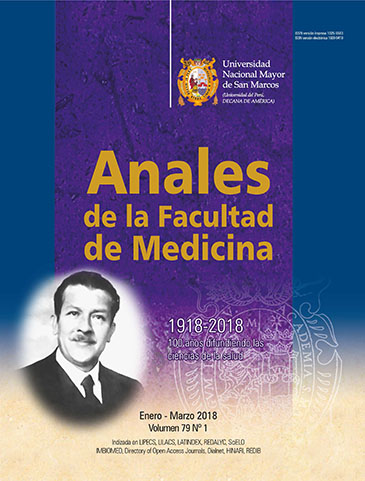Vulvodynia: Up to date
DOI:
https://doi.org/10.15381/anales.v79i1.14593Keywords:
Vulvodynia, Pain, ReviewAbstract
Vulvodynia is defined as vulvar discomfort, described as a burning pain with an average duration of 3 months and a prevalence of 16%. The methodology used consisted of a systematic review and analysis in electronic databases, through the use of keywords. The etiology remains unknown, despite the fact that various theories maintain that it has a multifactorial origin. The diagnosis of vulvodynia is made through a thorough evaluation of the history of pain, sexual history, clinical situation and physical examination. Non-medical treatment includes psychological interventions that aim to reduce pain and restore sexual function. Alternative therapies have not yet proven effective for the treatment of vulvodynia, while physical therapy, by helping to reduce tissue restrictions, helps restore the length of the muscles and tissues of the pelvis. Likewise, medical treatment includes local therapy, through the use of antinociceptives, anti-inflammatory agents and neuromodulators; It also uses tricyclic antidepressants, norepinephrine and anticonvulsants. Surgical treatment has been shown to be a strategy to reduce pain and the surgeon's experience should be taken into account as a determining factor. In conclusion, vulvodynia is a health problem for women that affects their sexual function, quality of life and treatment must be approached with a holistic and multidisciplinary approach.Downloads
Published
2018-06-07
Issue
Section
Artículos de Revisión
License
Copyright (c) 2018 Anales de la Facultad de Medicina

This work is licensed under a Creative Commons Attribution-NonCommercial-ShareAlike 4.0 International License.
Those authors who have publications with this magazine accept the following terms:
- Authors will retain their copyrights and guarantee the journal the right of first publication of their work, which will be simultaneously subject to Creative Commons Attribution License that allows third parties to share the work as long as its author and its first publication this magazine are indicated.
- Authors may adopt other non-exclusive licensing agreements for the distribution of the version of the published work (eg, deposit it in an institutional electronic file or publish it in a monographic volume) provided that the initial publication in this magazine is indicated.
- Authors are allowed and recommended to disseminate their work over the Internet (eg: in institutional telematic archives or on their website) before and during the submission process, which It can produce interesting exchanges and increase quotes from the published work. (See El efecto del acceso abierto ).
How to Cite
1.
Matzumura-Kasano JP, Gutiérrez-Crespo HF, Zamudio-Eslava LA. Vulvodynia: Up to date. An Fac med [Internet]. 2018 Jun. 7 [cited 2024 Jul. 3];79(1):53-9. Available from: https://revistasinvestigacion.unmsm.edu.pe/index.php/anales/article/view/14593















